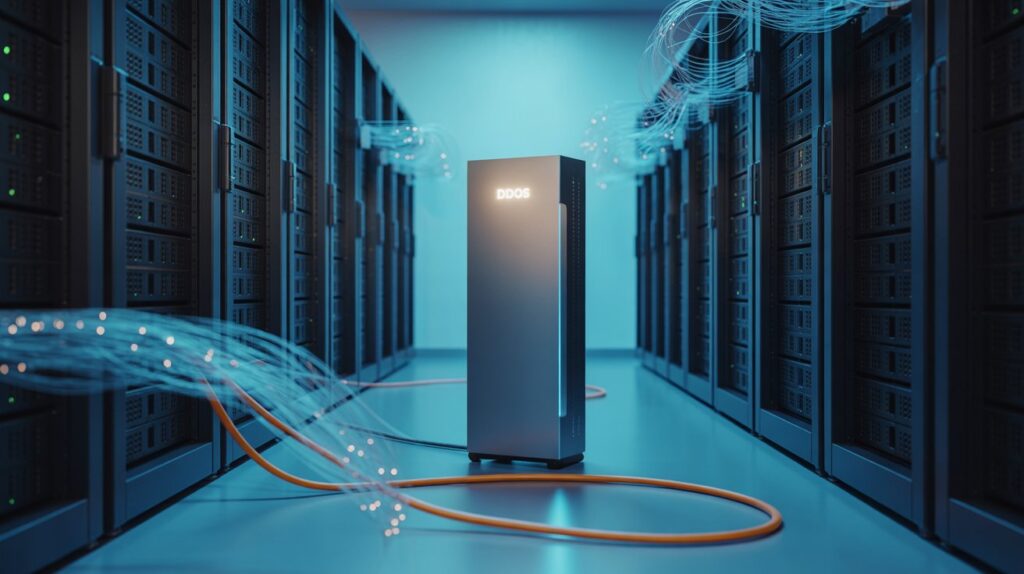Network security needs good tools right at the source – that’s where on-premise DDoS protection comes in. These specialized machines sit inside an organization’s network, watching and filtering traffic as it flows through.
They don’t send anything to the cloud, which means faster responses when attacks hit. A lot of places that can’t afford even a split second of delay, like hospitals or trading firms, depend on these systems to keep their networks running smoothly.
Key Takeaway
- These machines work right where you need them, filtering bad traffic before it can do damage
- They look deep into network traffic to catch both massive attacks and sneaky ones that try to slip through
- While they give you total control, you’ll need space for the hardware and people who know how to run it (most places use them alongside cloud protection)
Core Components and Mitigation Mechanisms
To really understand these defense systems, you’ve got to look at what’s inside them. Every piece has to work fast – we’re talking about checking thousands of data packets per second.
Hardware Appliances
The real muscle comes from specialized hardware boxes. Some are small enough to sit on a desk and handle a few hundred megabits per second, while others fill whole server racks and can process terabits of data. They’re built specifically for this job, and it shows in how well they perform.
High-Performance Traffic Inspection and Low Latency Processing
These machines don’t mess around when it comes to speed. They use custom chips (called ASICs) and specialized processors to check traffic without slowing things down. That’s crucial when you’re dealing with time-sensitive operations.
Traffic Analysis Tools
The brains of the operation comes down to two main parts. There’s deep packet inspection, which looks inside each piece of data to spot anything fishy, and flow analysis that watches how traffic moves over time to catch weird patterns.
Network Firewalls and Rules
The first line of defense uses pre-set rules to block known threats and limit suspicious traffic. These systems pull in new threat data automatically, so they’re always up to date on the latest attacks.
Management Systems
Everything runs through one control center where network teams can adjust settings and watch what’s happening. Bigger companies can even manage multiple networks from the same screen.
Attack Types Mitigated
These systems handle all sorts of attacks, each needing its own defense strategy.
Volumetric Attacks: UDP/TCP Amplification, DNS Floods
Think of these as the brute force attack methods, they try to flood networks with massive amounts of junk traffic. The appliances catch and drop this traffic before it can do harm. [1]
Application-Layer Attacks: HTTP/S Floods
These attacks are trickier – they look like normal website visits but come in huge numbers. The systems use behavior analysis to spot what’s real and what isn’t.
Low-and-Slow Attacks
Some attackers try to sneak past defenses by sending tiny amounts of bad traffic over long periods. The flow analysis tools catch these subtle attacks that might otherwise slip through.
Scalability and Capacity
We often get asked how these appliances perform as attack volumes grow. The short answer is scalability varies by model and deployment design.
Single and Cluster Appliance Deployments
Single appliances can defend networks with moderate traffic volumes, but for large enterprises, clustering multiple units is common. Clusters share the load, scaling up mitigation capacity and offering redundancy.
Throughput Range from Mbps to Tbps
Appliances range widely in throughput. For example, some handle around 200 Mbps, suitable for small businesses or branch offices. Others scale up to multiple terabits per second, fitting data centers or nationwide networks.
Advantages and Limitations of On-Premise Appliances
Credits: AWS Events
No technology is perfect. We’ve weighed the pros and cons from our own deployments and analyses.
Benefits
- Full Control and Faster Response: Local mitigation means no dependency on ISP or cloud scrubbing centers, speeding incident response.
- Customizable Protection per Network Needs: Tailor-made policies address unique traffic profiles and compliance requirements.
- Fixed Costs Without Bandwidth Charges: Unlike cloud services billed by traffic volume, on premise appliances involve upfront investment but predictable ongoing expenses.
- Reduced Latency through Local Processing: Critical for applications where every millisecond counts, such as financial trading or telemedicine.
Challenges
- Physical Infrastructure Requirements: Space, power, and cooling need to be factored in, which might be a hurdle for smaller organizations.
- Need for Skilled Personnel: Operating these systems demands expertise in network security and DDoS mitigation.
- Hardware Capacity Constraints vs. Large-Scale Attacks: Appliances can be overwhelmed by massive attacks beyond their design limits.
- Capital Expenditure and Maintenance Costs: Initial purchase, updates, and hardware refresh cycles add to total cost of ownership.
Use Cases and Market Examples
Certain sectors benefit most from on premise DDoS mitigation due to compliance, sensitivity, or latency demands.
- Government and Military Networks: Where classified data cannot leave premises for privacy or security reasons.
- Healthcare Providers: Protecting patient data and ensuring availability during emergencies.
- Financial Institutions: Latency-sensitive trading platforms require swift local mitigation.
- Latency-Sensitive and Compliance-Driven Environments: Any network that can’t afford the round-trip delay to cloud scrubbing centers or must comply with strict data residency laws.
Leading Appliance Models
While we avoid naming competitors, it’s worth noting that leading appliances offer capacities from hundreds of Mbps to over a terabit per second, often featuring autonomous attack detection and layered protection strategies.
Integration in Hybrid Security Architectures
We believe on premise DDoS mitigation appliances form a vital piece of a broader defense strategy. Because attack frequency and size keep rising, Cloudflare’s recent stats show a 358% year-over-year increase, many organizations combine on premise appliances with cloud-based DDoS protection for flexible, scalable defense that includes local filtering and remote cloud scrubbing when needed. [2]
The hybrid model lets on premise devices handle smaller, frequent attacks locally, while cloud services absorb massive floods.
Practical Advice for Organizations Considering On Premise DDoS Appliances

If you’re thinking about deploying on premise DDoS mitigation to defend against a range of distributed denial of service threats, start by assessing your typical traffic volumes and risk models. Consider the physical space and expertise you have for managing hardware appliances. We recommend investing in training your security operations team to handle incident response swiftly.
Always plan for scalability, even if your current traffic is moderate, attacks can spike unexpectedly. Clustering appliances or integrating cloud-based fallback options provides resilience.
Keep your device firmware and threat intelligence feeds updated regularly. Automated attack signature updates reduce false positives and improve detection accuracy.
Lastly, balance your budget between capital expenditure and operational costs. Although on premise appliances might appear costly upfront, fixed costs and tailored protection often pay off by preventing costly downtime and data breaches.
FAQ
How does an on-premise DDoS mitigation appliance handle both volumetric attack mitigation and application layer attack defense without causing latency in sensitive networks?
An on-premise DDoS mitigation setup often uses high throughput mitigation devices, hardware DDoS mitigators, and inline network security to stop volumetric DDoS solutions from overwhelming bandwidth. At the same time, it applies deep packet inspection, HTTP flood protection, and DNS attack prevention for application layer attack defense.
In latency sensitive networks, traffic filtering devices and packet filtering hardware work alongside rate limiting and false positive reduction techniques to avoid performance drops.
What factors determine the DDoS mitigation capacity and scalability of a hardware-based mitigation appliance in a growing threat landscape?
Mitigation appliance scalability depends on network resilience, network appliance clustering, and capacity planning for DDoS attack types that are increasing in size. Factors include attack bandwidth scale, DDoS attack duration, and the ability to update attack signatures quickly.
With cyberattack trends 2025 showing more botnet attack defense needs, enterprises and data center security teams often weigh capital expenditure on security against regulatory compliance security demands.
In what cases would a hybrid DDoS mitigation approach be better than relying solely on cloud vs on-prem DDoS protection appliances?
Hybrid DDoS mitigation combines ISP DDoS protection, DDoS scrubbing appliances, and software-driven DDoS defense with on-premise DDoS mitigation hardware. This approach benefits latency sensitive networks by allowing real-time traffic analysis and traffic scrubbing locally while using cloud resources for large-scale volumetric DDoS solutions.
It supports multi-layer DDoS defense, traffic anomaly detection, and customer traffic prioritization for enterprise DDoS protection in high-risk sectors like healthcare, financial, and government network protection.
How can security operations teams use real-time traffic analysis and network anomaly detection to reduce false positives in automated attack mitigation?
Security operations teams often deploy network traffic monitoring and DDoS alert systems within the network operation center to spot anomalies. Real-time traffic analysis, deep packet inspection, and intrusion prevention systems can detect SYN flood detection, UDP flood protection, and DNS amplification attack attempts.
Combining traffic rate control with security policy management helps in autonomous attack mitigation while maintaining customer traffic prioritization and false positive reduction.
What maintenance and operational practices extend the life and reliability of a low latency security appliance used for distributed denial of service defense?
For long-term performance, hardware-based mitigation appliances require regular security appliance maintenance, attack signature updates, and intrusion prevention system tuning. In multi-tenant management environments or greenfield security deployments, maintaining updated network firewall rules, multi-layer DDoS defense strategies, and threat intelligence integration improves reliability.
This ensures consistent UDP flood protection, TCP flood mitigation, and DNS attack prevention while supporting network resilience and compliance with cyber resilience architecture standards.
Conclusion
On-premise DDoS mitigation appliances give organizations unmatched control over traffic filtering, keeping latency low and sensitive data in-house. They demand resources, but when paired with cloud-based scrubbing, they form a layered defense ready for today’s threats.
By selecting and managing these tools strategically, security teams can stop attacks at the source without compromising performance.
See how NetworkThreatDetection.com can strengthen your defenses, Join here.
References
- https://www.sciencedirect.com/topics/computer-science/amplification-attack
- https://deepstrike.io/blog/ddos-attack-statistics


